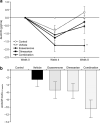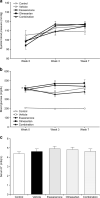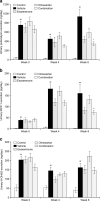Synergistic reduction in albuminuria in type 2 diabetic mice by esaxerenone (CS-3150), a novel nonsteroidal selective mineralocorticoid receptor blocker, combined with an angiotensin II receptor blocker
- PMID: 32616846
- PMCID: PMC7685977
- DOI: 10.1038/s41440-020-0495-0
Synergistic reduction in albuminuria in type 2 diabetic mice by esaxerenone (CS-3150), a novel nonsteroidal selective mineralocorticoid receptor blocker, combined with an angiotensin II receptor blocker
Abstract
Esaxerenone is a novel selective mineralocorticoid receptor (MR) blocker that was recently approved in Japan to treat hypertension. In phase II and III studies, esaxerenone plus a renin-angiotensin system inhibitor markedly reduced the urinary albumin-to-creatinine ratio (UACR) in hypertensive patients with diabetic nephropathy. To evaluate a direct renoprotective effect by MR blockade independent of an antihypertensive effect in the context of diabetic nephropathy, esaxerenone (3 mg/kg), olmesartan (an angiotensin II receptor blocker; 1 mg/kg), or both were orally administered to KK-Ay mice, a type 2 diabetes model, once daily for 56 days. Urinary albumin (Ualb), UACR, and markers, such as podocalyxin, monocyte chemoattractant protein-1 (MCP-1), and 8-hydroxy-2'-deoxyguanosine (8-OHdG), were measured, along with systolic blood pressure (SBP), fasting blood glucose, and serum K+ levels. Prior to the initiation of drug administration, KK-Ay mice showed higher blood glucose, insulin, Ualb excretion, and UACR levels than C57BL/6 J mice, a nondiabetic control, indicating the development of diabetic renal injury. Combined treatment with esaxerenone and olmesartan significantly reduced the change in UACR from baseline compared with the change associated with vehicle at week 8 (-1.750 vs. 0.339 g/gCre; P < 0.002) and significantly inhibited the change in Ualb from baseline compared with the change associated with vehicle at week 8 (P < 0.002). The combination treatment also reduced urinary excretion of podocalyxin and MCP-1, but did not influence 8-OHdG excretion, SBP, blood glucose, or serum K+ levels. Overall, esaxerenone plus olmesartan treatment ameliorated diabetic nephropathy in KK-Ay mice without affecting SBP, suggesting that the renoprotective effects of esaxerenone could be exerted independently of its antihypertensive effect.
Keywords: Albuminuria; Angiotensin II receptor blocker; Diabetic nephropathy; Esaxerenone; Mineralocorticoid receptor blocker.
Conflict of interest statement
All authors are employees of Daiichi Sankyo Co., Ltd., Tokyo, Japan.
Figures




References
-
- Masakane I, Taniguchi M, Nakai S, Tsuchida K, Goto S, Wada A, et al. Annual dialysis data report 2015, JSDT renal data registry. Ren Replacement Ther. 2018;4:19. doi: 10.1186/s41100-018-0149-8. - DOI
MeSH terms
Substances
LinkOut - more resources
Full Text Sources
Medical
Research Materials
Miscellaneous

